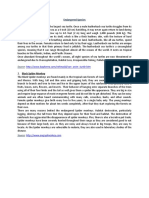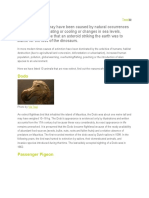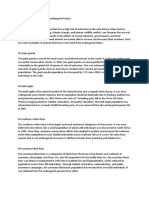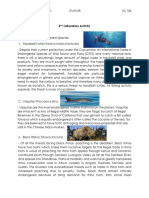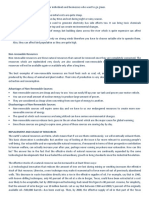Source: 1. 2.: 1. Giant Panda
Source: 1. 2.: 1. Giant Panda
Uploaded by
chetanCopyright:
Available Formats
Source: 1. 2.: 1. Giant Panda
Source: 1. 2.: 1. Giant Panda
Uploaded by
chetanOriginal Title
Copyright
Available Formats
Share this document
Did you find this document useful?
Is this content inappropriate?
Copyright:
Available Formats
Source: 1. 2.: 1. Giant Panda
Source: 1. 2.: 1. Giant Panda
Uploaded by
chetanCopyright:
Available Formats
depths of the oceans.
Only about 10,000 to 25,000 blue whales still swim in the world’s oceans. Soviet whaling ships hunted
them aggressively for whale oil in the 1900s, causing them to nearly become extinct. From 1900 to the
mid-1960s, about 360,000 blue whales were slaughtered. In 1966 they were placed on the protected list
International Whaling Commission, which made commercial whaling illegal, but their numbers never
recovered. But every year many sustain injuries from collisions with ships. Environmental change such as
habitat loss and toxins in the ocean also threaten the massive marine mammals. Oil spills and garbage
that collect in the oceans pose a risk to these great sea beasts. Blue whales gained endangered status in
1986 by the World Conservation Union (IUCN) Red List, are still on the list today.
Source:
1.http://guardianlv.com/2014/06/endangered-species-blue-whales-are-the-largest-mammals-that-ever-
lived/
2. http://www.worldwildlife.org/species/blue-whale
1. Giant Panda
This peaceful creature with a distinctive black and white coat is adored by the world and considered a
national treasure in China. The panda also has a special significance for WWF because it has been WWF's
logo since our founding in 1961. The rarest member of the bear family, pandas live mainly in bamboo
forests high in the mountains of western China. A newborn panda is about the size of a stick of butter—
about 1/900th the size of its mother—but can grow to up to 330 pounds as an adult. These bears are
excellent tree climbers despite their bulk.
It has become one of the most endangered mammals in the world, with only 1,600 of them left.
Although they have been protected from hunting and on the Endangered Species list since 1984, pandas
are still disappearing. Due to the fact that pandas reproduce so infrequently, it is very difficult for their
population to recover from such a low point. Giant pandas are currently classified on IUCN’s Red List as
an endangered species.
One the main reasons that pandas have become endangered is habitat destruction. As the population in
China continues to grow, pandas’ habitat gets taken over by development, pushing them into smaller
and less livable areas. Habitat destruction also leads to food shortages. Pandas feed on several varieties
of bamboo that bloom at different times of the year. If one type of bamboo is destroyed by
development, it can leave the pandas with nothing to eat during the time it normally blooms, increasing
the risk of starvation.
Source:
1. http://www.animalfactguide.com/animal-facts/giant-panda/
2. http://www.exploringnature.org/db/detail.php?dbID=7&detID=68
2. West African Black Rhinoceros
The black rhino, of which the western black rhinoceros is a subspecies, was most commonly located in
several countries towards the southeast region of the continent of Africa. It was a subspecies of
the black rhinoceros declared extinct by the IUCN in 2011. The western black rhinoceros measured 9.8–
12.3 ft long, had a height of 4.6–5.9 ft, and weighed 800–1,400 kg. It had two horns, the first measuring
1.6–4.6 ft and the second 0.79–21.65 inches. Like all Black Rhinos, their common diet included leafy
plants and shoots around their habitat. During the morning or evening, they would browse for food.
During the hottest parts of the day, they slept or wallowed. Like most black rhinos, they are believed to
have been nearsighted and would often rely on local birds, such as the red-billed oxpecker, to help them
detect incoming threats.
It was once widespread in the savanna of sub-Saharan Africa, but its numbers declined due to poaching.
Many people believe their horns held medicinal value, which lead to heavy poaching. However, this
belief has no grounding in scientific fact. Between 1960 and 1995 an astonishing 98 percent of black
rhinos were killed by poachers, either to feed the new and voracious demand for TCM or, to a lesser
extent, for horns to be used as ceremonial knife handles in the Middle East. All rhinos suffered; the
western black rhino, already weakened by decades of overhunting, was the hardest hit.
Source:
1. http://blogs.scientificamerican.com/extinction-countdown/2013/11/13/western-black-rhino-extinct/
2. http://en.wikipedia.org/wiki/Western_black_rhinoceros
3. Pyrenean Ibex:
The recently extinct Pyrenean ibex, also known by the Spanish common name bucardo, was one of the
four subspecies of wild goat to inhabit the Iberian Peninsula. The Pyrenean ibex had greyish brown fur
that grew thicker in winter. Males had striking black coloring on their legs, neck, and face. Males also
had large, thick, curving horns with ridges that deepened with age. Females' horns were much shorter
and thinner.
The ibex are thought to have numbered some 50,000 historically, but by the early 1900s its numbers
had fallen to fewer than 100. While the exact cause of the Pyrenean ibex's extinction is unknown,
scientists hypothesize that a number of different factors contributed to the decline of the species,
including poaching, disease, and the inability to compete with other domestic and wild ungulates for
food and habitat. The last Pyrenean ibex, a female nicknamed Celia, was found dead in northern Spain
on Jan. 6, 2000, killed by a falling tree. Scientists took skin cells from the animal's ear and preserved
them in liquid nitrogen, and in 2009 an ibex was cloned, making it the first species to become
"unextinct." However, the clone died just seven minutes later due to lung defects.
Source:
1. http://endangeredspecies.about.com/od/extinctionpastandpresent/a/Pyrenean-Ibex.htm
2.http://www.mnn.com/earth-matters/animals/photos/10-animals-presumed-extinct-in-the-last-
decade/pyrenean-ibex
4. Sea Mink
The sea mink is an extinct North American member of the family Mustelidae. It is the only mustelid, and
one of only two terrestrial mammal species in the order Carnivora, to become extinct in historic times
You might also like
- The Short Happy Life of Francis MacomberDocument8 pagesThe Short Happy Life of Francis MacomberirinasincuNo ratings yet
- Lesson Plan Class: V Subject: E.V.S. Chapter - 1: Super Senses This Lesson Needs 3 Sessions To CompleteDocument19 pagesLesson Plan Class: V Subject: E.V.S. Chapter - 1: Super Senses This Lesson Needs 3 Sessions To CompleteKrishna VeniNo ratings yet
- Endangered Species Eatherback Sea Turtle: SourceDocument4 pagesEndangered Species Eatherback Sea Turtle: SourcechetanNo ratings yet
- Endangered SpeciesDocument2 pagesEndangered SpeciesspiritusNo ratings yet
- Extinct AnimalsDocument6 pagesExtinct Animalsthasarathanr1993_939No ratings yet
- Animal ExtinctionsDocument8 pagesAnimal ExtinctionsKanishkNo ratings yet
- Faculty of Medical Scienses-: University 'Goce Delcev'' StipDocument8 pagesFaculty of Medical Scienses-: University 'Goce Delcev'' StipStojance IlievskiNo ratings yet
- Timeline of The Specified Species.Document9 pagesTimeline of The Specified Species.Gabriel GarlandoNo ratings yet
- Most Endangered AnimalsDocument13 pagesMost Endangered AnimalsKashish UpadhyayNo ratings yet
- Red Data Book 2.0Document12 pagesRed Data Book 2.0MOULIK MITTALNo ratings yet
- Extinct and Endangered Animals OF INDIADocument8 pagesExtinct and Endangered Animals OF INDIASunil100% (2)
- Blank 5Document13 pagesBlank 5Shehab IbrahimNo ratings yet
- Text ReportDocument6 pagesText Reportgentarevolusi63No ratings yet
- AnimalsDocument8 pagesAnimalsMikaela DimitrovaNo ratings yet
- Giant Panda (Ailuropoda Melanoleuca) : Jeff Tinsley/Smithsonian InstitutionDocument3 pagesGiant Panda (Ailuropoda Melanoleuca) : Jeff Tinsley/Smithsonian InstitutionSuryajeeva SuresNo ratings yet
- World Wildlife DayDocument35 pagesWorld Wildlife DayLeah Liza CasandaNo ratings yet
- Animals in DangerDocument11 pagesAnimals in DangerBojana MihajlovaNo ratings yet
- IE2 Course Pack - Reading MaterialDocument15 pagesIE2 Course Pack - Reading MaterialKim Hoang TaNo ratings yet
- The Rarest Animal in The World: Amur LeopardDocument4 pagesThe Rarest Animal in The World: Amur LeopardPrincess Kaye MontefalcoNo ratings yet
- Endangered Species of PakistanDocument7 pagesEndangered Species of PakistanJawad100% (9)
- Endangerd AnimalsDocument2 pagesEndangerd AnimalsCandy KittyNo ratings yet
- aniamls in dangerDocument12 pagesaniamls in dangerGisselle AlemánNo ratings yet
- Non Fiction BookletDocument3 pagesNon Fiction Bookletmyspg0291No ratings yet
- Specific Species of Extinct Animal or About To Become ExtinctDocument17 pagesSpecific Species of Extinct Animal or About To Become ExtinctRandom RandonNo ratings yet
- Rhinoceros PDFDocument2 pagesRhinoceros PDFSatyabrat DuttaNo ratings yet
- Environment PPT Template 022Document20 pagesEnvironment PPT Template 022Kalai ShanNo ratings yet
- Keystone SpeciesDocument4 pagesKeystone SpeciesJEZUE REMULTANo ratings yet
- MyClass PC Adv 77Document5 pagesMyClass PC Adv 77rebecaNo ratings yet
- White Rhinoceros: San Diego Wild Animal ParkDocument15 pagesWhite Rhinoceros: San Diego Wild Animal ParkJyotirmoy ThakuraNo ratings yet
- Philippine BiodiversityDocument40 pagesPhilippine BiodiversityJoy Eva100% (2)
- PPTDocument40 pagesPPTMhaithan Hernandez CaliuagNo ratings yet
- Falling Stars: 10 of The Most Famous Endangered Species: Giant Panda (Ailuropoda Melanoleuca)Document6 pagesFalling Stars: 10 of The Most Famous Endangered Species: Giant Panda (Ailuropoda Melanoleuca)Lob NaNo ratings yet
- EndangeredDocument3 pagesEndangerednadiaddennisNo ratings yet
- Prezentare - Specii Pe Cale de DisparitieDocument6 pagesPrezentare - Specii Pe Cale de DisparitieIrina StefanNo ratings yet
- l2 Lecture 4 (Living Resources) Phil. BiodiversityDocument119 pagesl2 Lecture 4 (Living Resources) Phil. BiodiversityEdreign Pete MagdaelNo ratings yet
- Philippine Trivia NotesDocument24 pagesPhilippine Trivia NotesBeatrizArcinasCañedoNo ratings yet
- English ProjectDocument35 pagesEnglish ProjectHimanshu mishraNo ratings yet
- North American Porcupine Porc-Épic D'amérique Du Nord Puerco EspínDocument6 pagesNorth American Porcupine Porc-Épic D'amérique Du Nord Puerco EspínitsankurzNo ratings yet
- Endangered Animals - MarineDocument3 pagesEndangered Animals - MarineJoan JohnNo ratings yet
- Information About Andean Mountain CatsDocument2 pagesInformation About Andean Mountain CatsXdd XdNo ratings yet
- Examples of Keystone SpeciesDocument3 pagesExamples of Keystone SpeciesWENCY FLYNN SINGCAY100% (1)
- Extinct AnimalsDocument13 pagesExtinct AnimalsIyliahNo ratings yet
- Extinct and Endangered BirdsDocument17 pagesExtinct and Endangered Birdssoundsof stringsNo ratings yet
- The Most Endanger AnimalDocument8 pagesThe Most Endanger Animalkavindu rasanjaNo ratings yet
- Endangred Animals 1Document1 pageEndangred Animals 1ngọc trầnNo ratings yet
- A Conservation Success Story - Matching TFNGDocument2 pagesA Conservation Success Story - Matching TFNGSelena NguyenNo ratings yet
- The Endangered Mammals from Around the World : Animal Books for Kids Age 9-12 | Children's Animal BooksFrom EverandThe Endangered Mammals from Around the World : Animal Books for Kids Age 9-12 | Children's Animal BooksNo ratings yet
- Rhino Basic FactsDocument20 pagesRhino Basic FactsNAMELESWARAN SANGARA NANDA MoeNo ratings yet
- Endangered SpeciesDocument7 pagesEndangered SpecieslogineNo ratings yet
- Animal Extinction and Preservation - Animal Books | Children's Animal BooksFrom EverandAnimal Extinction and Preservation - Animal Books | Children's Animal BooksNo ratings yet
- Science Art IntegratedDocument10 pagesScience Art IntegratedAnanya kaushikNo ratings yet
- Reading Booklet: EndangeredDocument3 pagesReading Booklet: EndangeredAvneetNo ratings yet
- Conservation: CIE A-Level Biology Topic 18: BCCDocument3 pagesConservation: CIE A-Level Biology Topic 18: BCCkaushikNo ratings yet
- BiodiversityDocument60 pagesBiodiversityKatrina Issa A. GelagaNo ratings yet
- The 20 Weird Animals YouDocument3 pagesThe 20 Weird Animals YouDanie AlonzoNo ratings yet
- Smithsonian Doc 22Document8 pagesSmithsonian Doc 22api-302699882No ratings yet
- Endangered Animals in PeruDocument9 pagesEndangered Animals in Peruivan rivero atanacioNo ratings yet
- Ivory-Billed WoodpeckerDocument4 pagesIvory-Billed WoodpeckerSheena Mae GallerosNo ratings yet
- Biology Extinction ProjectDocument3 pagesBiology Extinction ProjectKenneth SorraNo ratings yet
- DrawntoextinctionDocument52 pagesDrawntoextinctionapi-269628653No ratings yet
- CALISTON, Rod Daniel (Lab 2)Document3 pagesCALISTON, Rod Daniel (Lab 2)Rod Daniel CalistonNo ratings yet
- I. Case Study CASE STUDY #1 - Industry Revolution and Economic GrowthDocument2 pagesI. Case Study CASE STUDY #1 - Industry Revolution and Economic GrowthchetanNo ratings yet
- Significance of PPC: 1. Economic GrowthDocument6 pagesSignificance of PPC: 1. Economic GrowthchetanNo ratings yet
- I. Production Possibility Curve (PPC)Document8 pagesI. Production Possibility Curve (PPC)chetanNo ratings yet
- Disadvantages of Renewable SourcesDocument11 pagesDisadvantages of Renewable SourceschetanNo ratings yet
- How To Conserve The EnvironmentDocument12 pagesHow To Conserve The EnvironmentchetanNo ratings yet
- In-Situ Conservation in India: Page - 1Document15 pagesIn-Situ Conservation in India: Page - 1chetanNo ratings yet
- Eco ProjectDocument13 pagesEco Projectchetan100% (2)
- Re - Monster 07 - Kanekiru KogitsuneDocument58 pagesRe - Monster 07 - Kanekiru KogitsuneissaxeragonNo ratings yet
- The Story of KeeshDocument3 pagesThe Story of KeeshAshy Lia100% (1)
- Hodgdon Reloading ManualDocument39 pagesHodgdon Reloading Manualpoisonknives78% (9)
- Perfect TOEFL Junior Practice Test Book 1Document151 pagesPerfect TOEFL Junior Practice Test Book 1Harum WibowoNo ratings yet
- ZT - Survival GunsDocument3 pagesZT - Survival GunsJonathan AllenNo ratings yet
- The Story of KeeshDocument5 pagesThe Story of KeeshGYNKY MONTERDENo ratings yet
- The First Voyage Round The World - Pigafetta's Account of Magellan's Voyage - Wikisource, The Free Online LibraryDocument90 pagesThe First Voyage Round The World - Pigafetta's Account of Magellan's Voyage - Wikisource, The Free Online LibrarySherre Nicole CuentaNo ratings yet
- 223 Remington - 55 Grain 22 Cal. (.224")Document1 page223 Remington - 55 Grain 22 Cal. (.224")andrewNo ratings yet
- Arcana Rising FinalDocument272 pagesArcana Rising FinalBrandon E. Paul100% (1)
- The Black RiderDocument10 pagesThe Black RiderFrank ChenNo ratings yet
- Demand For Recreational Wildlife LicensesDocument21 pagesDemand For Recreational Wildlife LicensesMatthew KlierNo ratings yet
- The Forsaken Crypts of Nightmares 01Document3 pagesThe Forsaken Crypts of Nightmares 01Heitor CamposNo ratings yet
- Day 1 Am English 4 q2 Module 5Document9 pagesDay 1 Am English 4 q2 Module 5Twice GmailNo ratings yet
- History of FirearmsDocument4 pagesHistory of FirearmsScribdTranslationsNo ratings yet
- Narative Bhs InggrisDocument19 pagesNarative Bhs InggrisAhmad Nagh BintoroNo ratings yet
- FFXII - TZA - Bazaar ChecklistDocument51 pagesFFXII - TZA - Bazaar ChecklistDika JayaNo ratings yet
- TamerDocument193 pagesTamerrafaelandres.guajardojaraNo ratings yet
- t2 H 408 Roman Gods Information Powerpoint - Ver - 1Document28 pagest2 H 408 Roman Gods Information Powerpoint - Ver - 1Dario Viano IonitaNo ratings yet
- Tomb of SorrowsDocument4 pagesTomb of SorrowsRobson ScozNo ratings yet
- Alberta Guide To Trapping Regulations 1Document32 pagesAlberta Guide To Trapping Regulations 1guangshuai LiuNo ratings yet
- Twilight 2013 - 93GS1302 Short Stories - SolitudeDocument47 pagesTwilight 2013 - 93GS1302 Short Stories - SolitudeBenoit JacotNo ratings yet
- King Solomon's Mines: Answer KeysDocument3 pagesKing Solomon's Mines: Answer KeysSuvasini PoudyalNo ratings yet
- Archery Shooting - The Skill of How To Shoot Archery TargetsDocument2 pagesArchery Shooting - The Skill of How To Shoot Archery Targetsfiqar rinengkuhNo ratings yet
- DoE WalkthroughDocument71 pagesDoE WalkthroughNEMILINo ratings yet
- H Rider Haggard - King Solomon's MinesDocument138 pagesH Rider Haggard - King Solomon's MinesKAWNo ratings yet
- Artemis and Orion's Servant Profile Material FGO IIDocument5 pagesArtemis and Orion's Servant Profile Material FGO IIDélcio MoreiraNo ratings yet
- Owls Grade 7Document4 pagesOwls Grade 7Salma BazziNo ratings yet
- Gray Hands - A Waterdeep Dragon Heist DM's ResourceDocument14 pagesGray Hands - A Waterdeep Dragon Heist DM's ResourceGodsendNo ratings yet


